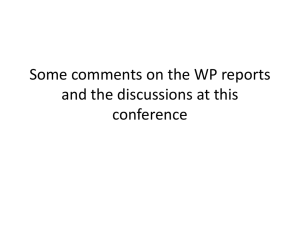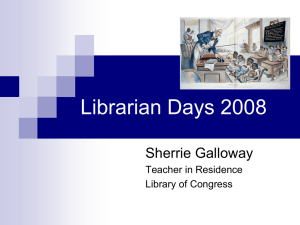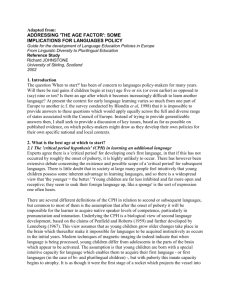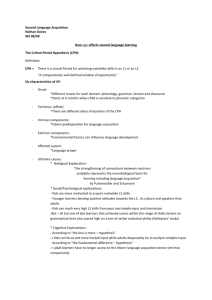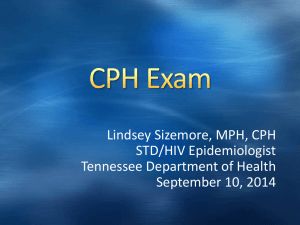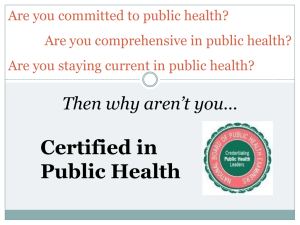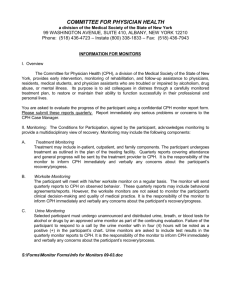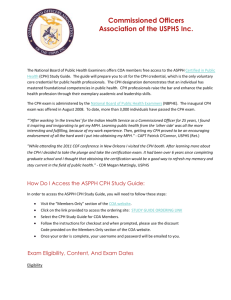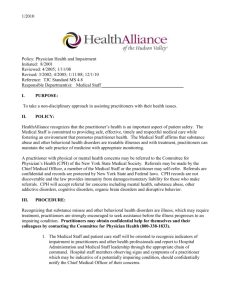Center for Professional Health
advertisement
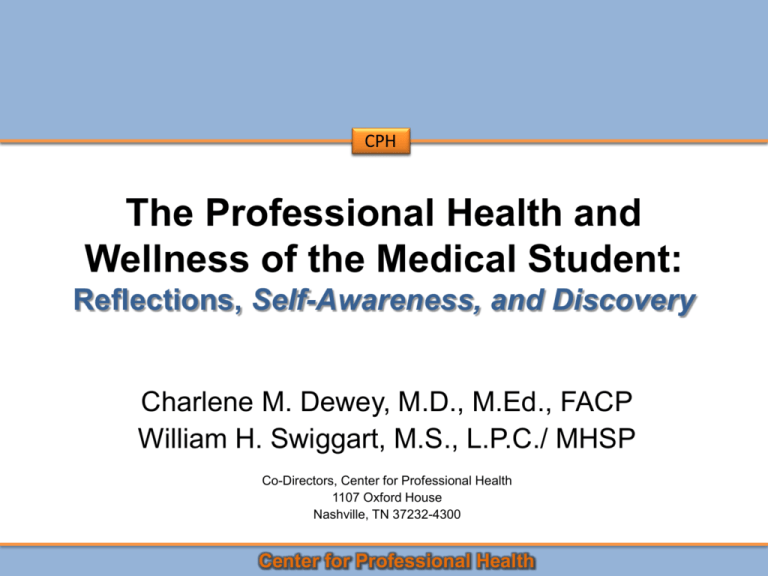
CPH The Professional Health and Wellness of the Medical Student: Reflections, Self-Awareness, and Discovery Charlene M. Dewey, M.D., M.Ed., FACP William H. Swiggart, M.S., L.P.C./ MHSP Co-Directors, Center for Professional Health 1107 Oxford House Nashville, TN 37232-4300 Center for Professional Health Goal CPH This session will encourage learners to reflect on several factors within their lives that will influence their professional health and wellness and how these factors and their self-awareness can help maintain professional wellness and professional boundaries. Center for Professional Health Objectives CPH Learners will: 1. Reflect on their personal characteristics and family of origin and how these influence their specialty selection. 2. Share their specialty choices and discuss how their personal characteristics will influence their behaviors in that career choice. 3. Interpret/value how professional health and wellness influences boundary and professionalism lapses. 4. Identify their stress triggers and how they respond in stressful situations. 5. Recognize the behaviors associated with flooding and select appropriate means for handling flooded colleagues, teammates, and family members. Center for Professional Health Agenda CPH 1. Introduction 2. Small Group Session #1 – – – Self-awareness & personality inventories Family roles Specialty choices & hidden curriculum 3. Professional Health & Wellness (large group) 4. Small Group Session #2 – – – Professional health and wellness Dealing with the flooded colleague/team member Emotional intelligence 5. Summary & evaluations Center for Professional Health Survey Results CPH • • • • N=53 (44%) Age: 17.5 (ave); 15 (mode); ,5-26 (range) 49 comments; 30(61%) = “help people” 23% = reason changed over time; 76.5% no change Center for Professional Health Survey Results CPH • Specialty: • 23% ped sub • 23% other • 12.5% IM sub • • • • 11 of 16 personality types I:E ratio is 1:2 (36%=I and 64%=E) 22.6% = ENFJ 37% = divided into: ESFJ, ISTJ & INTJ (13%, 13%, Center for Professional Health 11%) Personality & Careers CPH • How old were you? • A personal story Center for Professional Health Self-Awareness CPH • Key to emotional intelligence • Leads to self-control Center for Professional Health Personality Types CPH The Sixteen Types US Population Breakdown The table organizing the sixteen types was created by Isabel Myers (an INFP). ISTJ ISFJ INFJ INTJ 11–14% 9–14% 1–3% 2–4% ISTP ISFP INFP INTP 4–6% 5–9% 4–5% 3–5% ESTP ESFP ENFP ENTP 4–5% 4–9% 6–8% 2–5% ESTJ ESFJ ENFJ ENTJ 8–12% 9–13% 2–5% 2–5% Estimated percentages of the 16 types in the population.[32] http://en.wikipedia.org/wiki/Myers-Briggs_Type_Indicator (Table copied May 1, 2011) Center for Professional Health Family Job Description CPH • Family roles Family Hero Caretaker/People Pleaser Scapegoat Lost Child Mascot/Clown • Job title • Job description Center for Professional Health Hidden Curriculum CPH • Not part of any printed curriculum • Messages we learn • Contributor or change agent? • Part of the problem or part of the solution? Center for Professional Health Small Groups 1-4 CPH Group 1 Group 2 Group 3 Group 4 Dewey, Charlene Swiggart, William Rodgers, Scott Lomis, Kim Adams, Carmen Michelle Aisagbonhi, Omonigho Augustina Andresen, Jennifer Michelle Andrade, Gabriela Ayers, Katie Binka, Edem Apple, Rachel Price Barnett, Brian Scott Bergman, Mica Yael Chiaghana, Chuks Deery, Sarah Blanco, Marissa Choxi, Ankeet Edwards, Kimberly Ann Furman, Adrian Arthur Bourne, Sarah Cooperstein, Emily Fuchs, Christian Jan Gebre-Amlak, Kassatihun Burjek, Nicholas Edward Eby, Kathryn Grace Hanif, Rimal Gregg, Justin Chi, Michael Eskind, David Hsu, Emory Hawley, Catherine Dhulipala, Sravan Choudary Fritz, Ryan Knowlton, Peter Hipp, Dustin Michael Maston, Emily Elizabeth Marcovitz, David Kohorst, Kelly Louise McConnaughey, Shannon Marie Musee, Joel Mariotti, Jolene Poon, Sabrina Ovalle, Fernando Myler, Conrad Spencer Schulte, Rachael Rae Chase Ruiz, Rachel Powers, Albert Russell, III Wright, Danielle Sullivan, Billy Wegner, Adam Michael Eshaghian, Daniel Friedlander, David Fallon Gregg, L. Parker Hames, Nicole Angele Lio, Elizabeth Center for Professional Health Allen, Amil Small Groups 5-8 CPH Group 5 Group 6 Group 7 Group 8 Cutrer, William B Logan, Carol Rozear Rush, Charles Clark, Nathaniel Fleming, Amy E Koehler, Daniel Ark, Jacob Tyler Moore, Ryan Davis Grayson, Britney Kirlew, Christine Lorraine Lewallen, James Bradford Kutaka, Julia Jeanne Durrani, Alia Pai, Anita Kochikar Mistry, Akshitkumar Maheshbhai Gartland, Matthew Grady Powers, Albert Russell, III Lominadze, Zurabi Opara, Rejoice Ngozi Bless Hooper, William Blake Parikh, Ravi Hungwe, Tendeukai Pennington, Joseph Daniel Jermakowicz, Walter John, III Real, Joe Schmidt, Alexandra Shpigel, Adam Arnold Sopfe, Jenna Toaz, Erin Tustin, Aaron Wayne Vucovich, Megan Weiner, Ashley Wilburn, clayton Woo, Kel Vin Meenderink, Leslie Michelle Nathan, Niraj O'Brien, Nathan Michael Patrawala, Samit Atul Perdigoto, Ana Saboori, Mazeyar Robinson, Jamie Sathiyakumar, Asmitha Kathleen Shih, Grace Chia-huei Steer, Jonathan Smith, Jason Stallings, Shannon Torossian, Artour Thurman, Alex Zackoff, Matthew Wolf, Michael Seth Tourjee, Stephen Mankata Center for Professional Health Knadler, Joseph Martin, Allison McHugh, Julia Sandler, Carla Walls, Morgan Breon Wurster, Victoria Zuckerman, Scott Lawrence Small Group Activities CPH • • • • • Small groups assigned Facilitator role Participant role 10 minute break Large group Center for Professional Health Professional Health & Wellness CPH Professional Health and Wellness Spectrum Work & Family Relations High Functioning High Productivity Fair Functioning Decreasing Productivity Fair Functioning Reduced Productivity Relationships Suffer Fair-Not Functioning Fair-Not Productive Institution & Family Loses Physical Mental Emotional Spiritual Stressed Professionally Healthy & Well Coping Mechanisms Strong A B C D E Burnout Coping Mechanisms Failing F G H Center for Professional Health Risk of MH issues and suicide No Coping Mechanisms I J K Maintain Health & Wellness CPH Seven Key Personal Areas: – – – – – – – Sleep Balanced meals Physical activity Socialization Vacations/down times Spiritual engagement Have a physician Center for Professional Health Six Sourc 1. Work 2. Lack 3. Insuff 4. Unfai 5. Break comm 6. Value Vanderbilt Center for Professional Health CPH Continuing Medical Education Courses Prescribing Controlled Drugs© Maintaining Proper Boundaries© Program for Distressed Physicians© www.mc.vanderbilt.edu/cph Center for Professional Health Course Demographics CPH Courses N Ave Age Sex Distressed 76 48 Boundaries 504 41 5% F 95% M Prescribing 661 50 11% F 88% M Total Distressed 12% F 88% M 1241 Boundaries Prescribing IM subspecialties* IM/FP IM/FM IM/FM Psychiatry Psychiatry OB/GYN Surgery Surgery Surgery OB/GYN ER *(interventionalists) Center for Professional Health Flooding* CPH • “This means you feel so stressed that you become emotionally and physically overwhelmed…” • “Pounding heart, sweaty hands, and shallow breathing.” • “When you’re in this state of mind…you are not capable of hearing new information or accepting influence.” *John M. Gottman, Ph.D. The Relationship Cure, Crown Publishers, New York, 2001, 74-78. Center for Professional Health CPH Center for Professional Health Which person is flooded? CPH Center for Professional Health CPH DRAN Center for Professional Health Describe CPH • Describe the other person’s behavior objectively • Use concrete terms • Describe a specified time, place & frequency of action • Describe the action, not the “motive” Center for Professional Health Reinforce CPH • Recognize the other person’s past efforts Center for Professional Health Assert Directly & Specifically CPH • • • • Express your feelings Express them calmly State feelings in a positive manner Direct yourself to the offending behavior, not the entire person’s character • Ask explicitly for change in the other person’s behavior Center for Professional Health Negotiate: Work Towards A Compromise That is Reasonable CPH • Request a small change at first • Take into account whether the person can meet your needs or goals • Specify behaviors you are willing to change • Make consequences explicit • Reward positive changes Center for Professional Health Emotional Intelligence CPH Five components of emotional intelligence: 1. Self-awareness 2. Self-regulation 3. Motivation 4. Empathy 5. Social skill Center for Professional Health Summary CPH • Reflection • Self-awareness • Discovery Center for Professional Health
